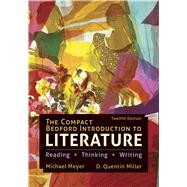The Compact Bedford Introduction to Literature is a bestseller for a reason: It brings literature to life for students, helping to make them lifelong readers, better writers, and more critical thinkers in any path they choose. Classic works drawn from many periods and cultures appear alongside a strong showing from today’s authors. There is plenty of support for students, with critical reading and writing support, helpful sample close readings, writing assignments, and student papers in up-to-date MLA style.
And, because everyone teaches and learns differently, there are many options for working with the literature, including case studies on individual works and themes that everyone can relate to. In-depth chapters on major authors including Flannery O’Connor and Nathaniel Hawthorne take students deeper into their work, and three chapters on the fiction of Dagoberto Gilb and the poetry of Billy Collins and Julia Alvarez—created in collaboration with the authors themselves—are one more way that the anthology showcases literature as a living, changing art form.
Achieve with Meyer, Compact Bedford Introduction to Literature, puts student reading, writing, and revision at the core of your course, with interactive close reading modules, reading comprehension quizzes for the selections in the book, videos of professional writers and students discussing literary works, and a dedicated composition space that guides students through draft, review, source check, reflection, and revision. For details, visit macmillanlearning.com/college/us/englishdigital.









